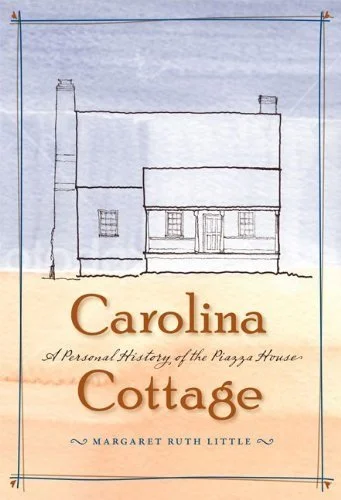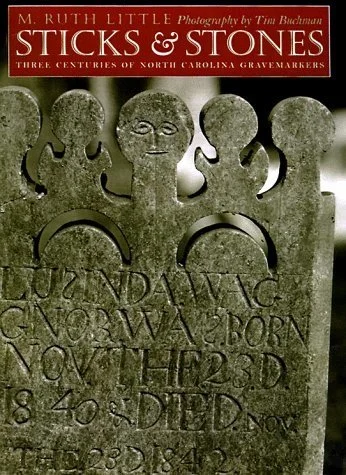Writing
The Book of Ruth: Taming Ghosts, Saving History
Summary by publisher Nora Esthimer: Ruth Little's memoir, The Book of Ruth, shows what happens when an artist and a historian inhabit the same life. The ghosts she tames are those she carries from her childhood and those she finds in the lost places of North Carolina. The artist examines those ghosts from all sides and uses her art to understand them. The historian sees old and forgotten houses, crab shacks, commercial and farm buildings. The artist envisions the lives that once inhabited them, and the historian fights to preserve them so that we may all remember.
Brett Sturm, restoration specialist, NC State Historic Preservation Office, writes on the back cover that "Rigorous, observant, colorful, and brave, the Book of Ruth weaves together threads of social history, family history, and architectural history to create a moving story of a life, shaped, like all lives, by context--people and place. Her example shows us that keeping faith in one's creative, intellectual, and personal aspirations can be precisely the ingredient that sets us free."
The Book of Ruth: Taming Ghosts, Saving History, published spring 2022 by Lystra Books of Chapel Hill, N.C.
Vade Mecum Resort Historic Architecture Evaluation
The 1902 Vade Mecum Springs Hotel
Vade Mecum Resort Historic Architecture Evaluation, completed in 2021 by Longleaf Historic Resources for HH Architecture of Raleigh. The 1902 Vade Mecum Springs Hotel is one of the few turn-of-the-century resort hotels of the North Carolina mountains that has survived. Along with a stone chapel, a large gymnasium/auditorium, and early cabins built after the property became an Episcopal retreat and camp, the Vade Mecum complex is now owned by Hanging Rock State Park. It will be restored as a historic hotel and music venue with modern amenities.
"Rooted in Freedom: Raleigh, North Carolina's Freedmen's Village of Oberlin, an Antebelllum Free Black Enclave,"
The North Carolina Historical Review, October 2020, Vol. XCVII, pp. 425-450.
The freedmen's village of Oberlin, in Raleigh, was settled after the Civil War on Oberlin Road. Oral tradition credits its establishment to the Cameron family, who supposedly gave lots to their former slaves after emancipation. Ruth Little, a resident of Oberlin Village since 2006, researched old maps, censuses, estate papers, and published sources to see if the oral history is true. Her search uncovered a previously unknown enclave of five free Black families living along Oberlin Road in the present-day vicinity of Oberlin Cemetery in 1860, including the families of Jesse Pettiford and Benjamin Morgan, who owned their property. Instead of a Black settlement founded by generous slaveowners, Oberlin originated in freedom, with a small group of industrious free Black artisans who built homesteads there in the 1850s. After the Civil War, previously enslaved people purchased their lots from land developers and settled in Oberlin. Oberlin Village is the only known freedmen's village in North Carolina known to have roots as a free Black settlement. Ruth received an Award of Distinction for Preserving Oberlin Village History from the Friends of Oberlin Village in 2021.
First page of Oberlin Village article by Ruth Little.
Other books
An Inventory of Historic Architecture, Greensboro, N.C. City of Greensboro and N.C. Dept. of Cultural Resources, 1976.
An Inventory of Historic Architecture, Iredell County, N.C. Iredell County and the N.C. Dept. of Cultural Resources, 1978. (Reviewed in Winterthur Portfolio, 15:4, 1980.)
A Tale of Three Cities: A Pictorial Survey of Leaksville, Spray & Draper. Author, Claudia Brown. Editor, Ruth Little. Eden Historic Properties Commission: Eden, NC, 1986.
Coastal Plain and Fancy: The Historic Architecture of Lenoir County and Kinston. Kinston: City of Kinston and Lenoir County Historical Association, 1998.
Articles
"Vernacular Hospitality in the Carolinas: The Tidewater Cottage and the Preacher Room, ARRIS: Journal of the Southeast Chapter of the Society of Architectural Historians. Edited by David Gobel and E. G. Daves Rossell (Vol. 15, 2004), 26-38.
“The Other Side of the Tracks: The Middle-Class Neighborhoods that Jim Crow Built in Early-Twentieth-Century North Carolina,” Perspectives in Vernacular Architecture VII. Edited by Annmarie Adams and Sally McMurry (Knoxville: The University of Tennessee Press, 1997), 268-280.
"Afro-American Gravemarkers in North Carolina," Markers VI: The Journal of The Association For Gravestone Studies, Lanham, MD and London, England: University Press of America, Inc., 1989.
“Form and Style: The Keys to Architectural History,” Tar Heel Junior Historian, Vol. 29, No. 1, Fall 1989.
“Folk Art in Stone," Building The Backcountry: An Architectural History of Davidson County, N.C. Paul Baker Touart, The Davidson County Historical Association, 1987.
"The North Carolina Porch: A Climatic and Cultural Buffer," Carolina Dwelling, ed. by Doug Swaim. N.C. State University School of Design, 1978. (Reviewed in Pioneer America, 12:2, 1980.)
Preservation Manuals
"North Carolina Historic Preservation Office Survey Manual," Division of Archives & History, Raleigh, NC, December, 1989.
"Practical Advice For Preparing National Register Nominations In North Carolina," State Historic Preservation Office, Division of Archives & History, Raleigh, NC, 1988.
Walking Tour Scripts/Brochures
New Bern African American Heritage Brochure, 1999
"History Walk," historic plaque script for New Bern Avenue-Edenton Street Corridor Study, Raleigh," prepared for Paton/Zucchino & Associates, 1993.
Historic Oakwood Walking Tour Brochure, Raleigh, N.C. 1975
Reports
“Ailey Young House (Simmons Row),” Wake Forest, N.C.” 2009
“Historic Houses of Blount Street Commons, Raleigh, Historic and Architectural Evaluations,” 2008.
“The William T. Smith Plantation and Smithville, Cumberland and Harnett Counties, N. C., ca. 1750-2006,” 2006.
A Catalogue of Interpretative Materials: Historical Documents, Images, and Interviews Relating to the History of the Bull Durham American Tobacco Company Plant, Durham, N.C. and to Durham Tobacco History, 2001
“The Slave Hospital and the Large Slave Quarter at Somerset Place, N.C. ,” Architectural Research and Structures Report, 1999.
"The History and Architecture of Long Wharf and Greater Duffyfield: African-American Neighborhoods in New Bern," co-written with Dr. Tom Hanchett for the City of New Bern, North Carolina, 1993.
“Mainstreaming Historic Preservation: The Role of the Charlotte-Mecklenburg Historic Properties Commission in Land Use Planning,” Charlotte-Mecklenburg Historic Properties Commission, 1977.







